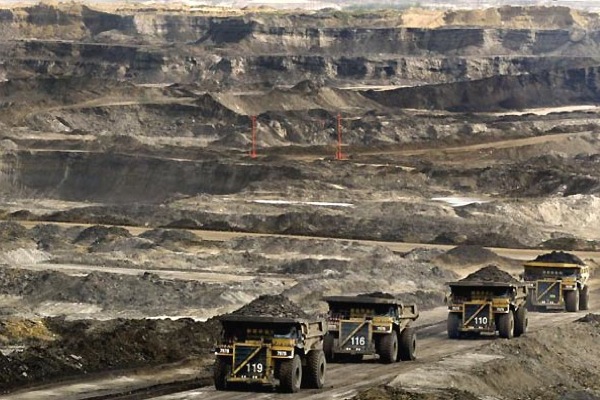
Mining at the Alberta oil sands. (Courtesy of Pembina Institute).
Canada’s federal government has promised to reduce its greenhouse gas emissions by 30% below 2005 levels by 2030, an ambitious target that, according to Environment Canada, includes plans for the oil sands sector.
The new emissions target, announced by Environment Minister Leona Aglukkaq in Winnipeg, aims to control emissions in three separate areas: methane releases from oil and gas extraction; natural-gas fired power plants, and the manufacture of chemicals and nitrogen fertilizers.
A spokesman for the ministry told MINING.com that despite rumours of the plan not setting specific rules to cut emissions in the oil sands, they are indeed considered as they are part of the oil and gas sector.
“Canada’s target is economy-wide and does not exclude anything,” he said in an emailed statement. “Further, the methane regulations announced yesterday are for the oil and gas sector of which the oil sands is part of. In 2012 10% of the oil and gas sector’s methane emissions came from the oil sands.”
The announcement comes more than three years after Canada abandoned its original emission reductions targets under the Kyoto Protocol, an international agreement Canada signed on to almost two decades ago.
The leader of the country, which has historically matched its targets with those set south of the border, said last month it was unlikely that Canada’s targets were to match the U.S. this time.
And as recently as December last year, Prime Minister Stephen Harper said regulating carbon emissions in the oil sands industry would be “crazy” at a time of depressed crude prices.
Alberta has its own regulations, which set per barrel limits and a $15-a-tonne levy on emissions that exceed those limits. Those regulations expire at the end of June and the incoming New Democratic Party (NDP) government has promised to move forward with new strategies to boost energy efficiency measures and renewable energy supplies.
The NDP, however, does not yet have a broader plan for reduction of growing greenhouse gas emissions from the energy sector, particularly the oil sands, which is a significant part of Alberta’s carbon footprint.
On the way up
Environment Canada’s most recent emissions inventory shows 726 megatonnes of emissions in the country in 2013 — up 1.5% from a year earlier — with Alberta responsible for 267 megatonnes.
The federal agency has said the growth of emissions from the oil sands will likely mean Canada will miss its 2020 climate change commitments under the Copenhagen accord.
Canada has seen emissions jump in the last four years, although some provinces such as Ontario and Quebec have been much more successful at reaching reduction goals than others.
Canada is required to release its emission targets for the G7 conference in Germany early next month. That meeting is in preparation for a crucial climate conference being held in Paris at the end of the year, where almost 200 countries will present their plans to cut carbon emissions over the next decade.
4 Comments
amadeusk331 .
Yeah, it’s not going to happen… This environment minister is about as clueless and vapid/a mindless incompetent, as that previous minister of vetran’s affairs was at his job…the majority of ministers incharge of their files in this government are greater clowns than you’d find in any travelling circus. These people are clueless and have completely lost touch with reality…That old saying goes, absolute power (a majority in this case) corrupts absolutely. They just do whatever the hell they want without regards to the people that voted them into their positions. They don’t realize, or are too damned oblivious to realize that just as quickly as we put them there, we can kick their asses to curb and their plum (working 5.5 months a year) jobs paying 6 figures will no longer exist – they’ll have to do real work like the rest of us at about half their parliamentary salary, which now, they feel they are entitled to. I voted for the Conservatives in the last election; I certainly will not be, this fall… for me C-51 and the amount wasted on another f***ing Iraq war is how they have completely lost my support.
UncompressedWAVmusic .
amadeusk331
Thanks a lot for your clarity, honesty and point of view.
I have been dissapointed in Harper’s dictatorship, censureship of enviroment scientists and willing to put the oil sands ahead of the global environment and also everything Harper does is as a control freak with his agenda to attack and shut down all who get in the way of his continuing to get re-elected including shutting down parliament instead of answering questions.
Harper is the first prime minister who has single handedly piece by piece been destroying Canada’s reputation and greatness to achieve his own personal agenda. Harper thinks he is King of Canada and can, has and will do unbelievable damage in as many ways as possible to get elected.
Harper should of been a cutthroat business owner instead of running a country.
Harper is an national embarassment who will toast anyone or anything who doesn’t follow his personal agenda including scientists, charities, and parliamentary rules which he doesn’t respect at all.
I feel that Stephan Harper has proven himself to be year after year the worst Prime Minister in the history of Canada and I believe history will reveal the incredible damage he has done to Canada. I believe Stephan Harper should be impeached as incompetant.
These are my opinions and feelings that I believe are shared by millions of Canadians.
Trevor
Actually, when they do get kicked to the curb they get a pension that covers them quite nicely…
Chris Armstrong
WOW ! Love the “bang on” commentary. Anybody that believes anything that Stephen Harper says is not considering his TRACK RECORD. Like his pre- election promise of “transparency” = ZERO TRANSPARENCY. And I used to be a relatively happy Conservative!